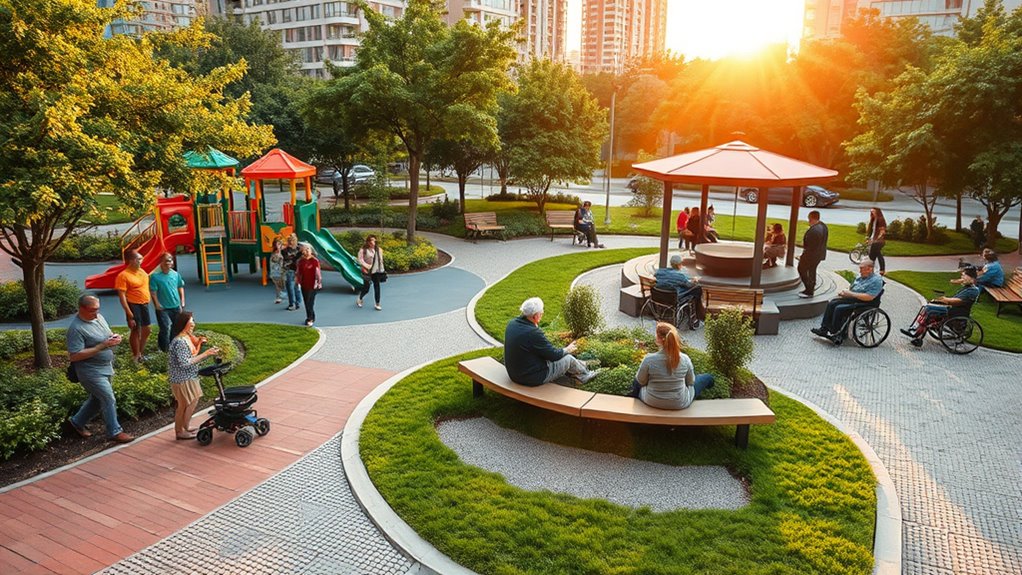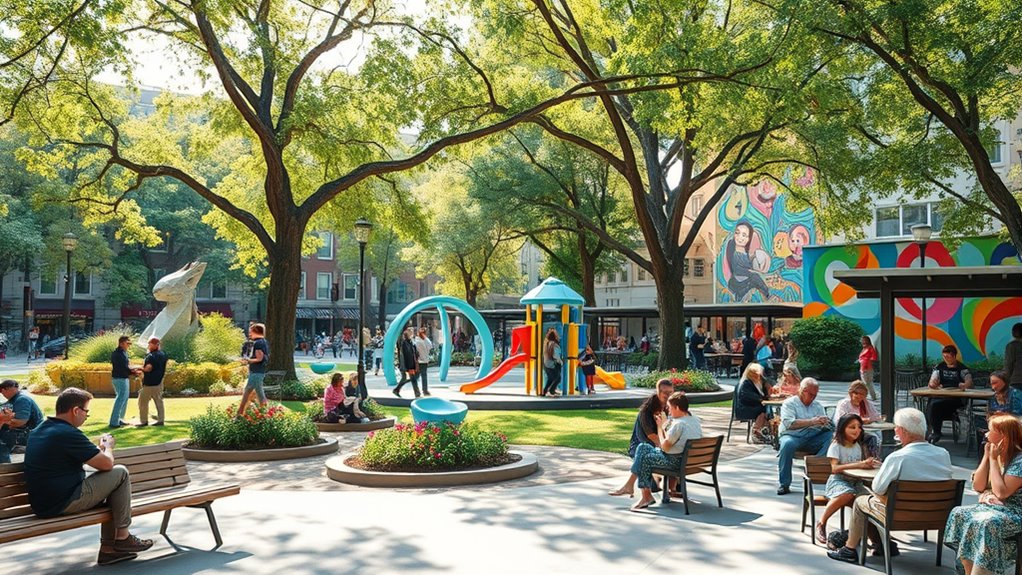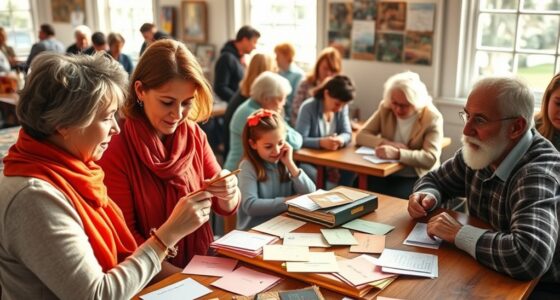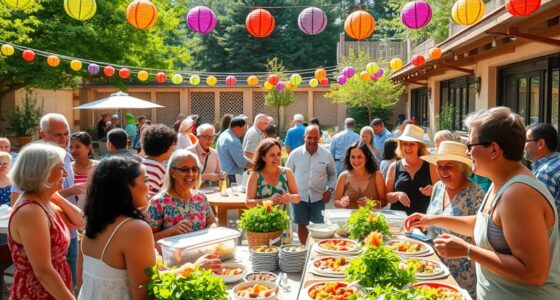When designing third spaces, focus on creating inclusive and accessible environments that reflect diverse cultures, traditions, and needs. Use adaptive features like adjustable seating, tactile pathways, and multilingual signage to make everyone feel welcome. Incorporate social elements such as open layouts, community storytelling, and natural features to encourage interaction and relaxation. Prioritize safety with good lighting and community involvement. Continue exploring these strategies to craft public areas that truly foster belonging for all.
Key Takeaways
- Inclusive and accessible design ensures diverse communities feel represented, safe, and comfortable, fostering a sense of belonging.
- Incorporating social interaction features like flexible seating and community storytelling promotes connection and shared identity.
- Thoughtful aesthetics, natural elements, and cultural symbols create welcoming environments that encourage longer stays and community bonding.
- Safety measures such as good lighting, signage, and community involvement build trust and a sense of security among users.
- Engaging community members in planning and management nurtures ownership, responsibility, and inclusive use of public spaces.
The Role of Inclusive Design in Public Spaces

Inclusive design plays a vital role in shaping public spaces that welcome everyone, regardless of their abilities or backgrounds. By emphasizing cultural inclusivity, you guarantee diverse communities feel represented and respected. Adaptive architecture allows spaces to flexibly serve different needs, making environments more welcoming. When designing, consider how cultural symbols, languages, and traditions can be integrated seamlessly. Adaptive features like adjustable seating, tactile pathways, and multilingual signage help break down barriers. Your goal is to create spaces where everyone feels comfortable and engaged. Incorporating Cultural Intelligence into design processes ensures spaces are sensitive to diverse cultural norms and practices, fostering a deeper sense of belonging. Recognizing the importance of user privacy and accessibility helps in creating welcoming environments that respect individual needs. Implementing inclusive design principles ensures that public spaces are equitable and usable for all community members. Designing with community engagement in mind can also uncover unique needs and foster a stronger sense of ownership among residents. Utilizing space optimization techniques can further enhance functionality and comfort within public areas. Inclusive design isn’t just about accessibility; it’s about recognizing and valuing diversity. By prioritizing cultural inclusivity and adaptive architecture, you foster public spaces that truly serve and unite all members of society.
Creating Accessible Environments for All

Designing environments that are accessible to everyone requires intentional planning and a clear understanding of diverse needs. Universal accessibility guarantees all individuals, regardless of abilities, can navigate and enjoy public spaces comfortably. To achieve this, consider features like ramps, tactile signage, and adjustable seating. Incorporating appropriate signage with clear symbols and text enhances understanding for users with different language backgrounds and cognitive abilities. Additionally, integrating body awareness principles can help designers create spaces that accommodate physical comfort and safety. Understanding the importance of angle adjustments can influence how spaces are organized for optimal usability and safety. Incorporating visual contrast is essential to ensure signage and displays are easily distinguishable and readable, especially for those with visual impairments. Cultural inclusivity is equally important, respecting different traditions, languages, and social norms. Incorporate multilingual signs and culturally relevant art to make everyone feel welcome. You should also involve community members from diverse backgrounds in the planning process, gaining valuable insights. By focusing on universal accessibility and cultural inclusivity, you create spaces where everyone feels valued and able to participate fully. Additionally, understanding the significance of contrast ratio in visual environments helps ensure that signage and displays are easily readable for all users. These thoughtful designs foster a sense of belonging, making third spaces truly open and welcoming for all.
Designing for Social Interaction and Community Engagement

How can we create spaces that naturally encourage social interaction and foster a sense of community? The key lies in thoughtful urban furniture design and facilitating community storytelling. Well-placed benches, tables, and movable chairs invite people to gather and converse. Incorporating features like bulletin boards or digital displays encourages community storytelling, sharing local stories and ideas. These elements make your space more inviting and engaging. Use the table below to see how different design choices promote interaction:
| Design Element | Impact |
|---|---|
| Flexible seating | Enables spontaneous conversations |
| Community storytelling | Fosters shared identity and belonging |
| Interactive installations | Sparks curiosity and engagement |
| Open layouts | Reduces barriers and invites movement |
| Multi-use furniture | Adapts to various activities, encouraging mingling |
Additionally, understanding community dynamics can help tailor these features to better meet the needs of local residents. Recognizing local cultural traditions can enrich the design, making spaces more meaningful and inclusive. Incorporating user preferences through feedback can further refine these elements to ensure they serve the community effectively. Moreover, integrating public space amenities like bike racks and charging stations can support diverse activities and attract a wider range of users. Implementing climate control solutions such as outdoor heating or shading can also make these spaces more comfortable year-round.
Incorporating Nature and Aesthetic Elements to Enhance Comfort

Adding natural and aesthetic elements to your space considerably boosts comfort and appeal. Incorporate biophilic design by including plants, natural light, and organic materials to create a calming atmosphere. These elements connect people to nature, reducing stress and fostering relaxation. Aesthetic enhancements like colorful artwork, textured surfaces, and thoughtfully chosen furniture also elevate the space’s visual appeal. When you prioritize these details, you make visitors feel more welcome and at ease. Natural elements not only improve air quality but also promote a sense of well-being. Incorporating public space hours can help optimize accessibility and ensure that visitors can enjoy these features when they are most comfortable. Understanding the importance of WWE Raw’s Financial Impact highlights how well-designed public spaces can similarly influence community engagement and economic vitality. Creating spaces with proper lighting can further enhance safety and comfort for visitors. By blending nature with carefully curated design features, you craft a third space that encourages social interaction and belonging. Incorporating elements that support mental health benefits can further enhance the overall experience for visitors. A well-designed environment that considers energetic alignment can foster positive vibes and emotional well-being within the community. Remember, a harmonious environment rooted in aesthetic enhancements invites people to linger and engage more deeply.
Strategies for Maintaining Safe and Welcoming Areas

Creating a safe and welcoming area requires proactive management and attentive design. You should implement security measures like well-lit spaces, visible signage, and surveillance cameras to deter trouble. Training staff and volunteers to handle conflicts calmly also helps maintain a positive environment. Building strong community partnerships ensures ongoing support and shared responsibility for safety. Engage local organizations, residents, and authorities in regular communication and collaborative efforts. Foster a sense of ownership among visitors by encouraging respectful behavior and inclusive practices. Clear rules and consistent enforcement help set expectations. By combining thoughtful security measures with active community involvement, you create a space where people feel secure and comfortable. Incorporating trustworthiness of Patchology principles such as transparency and quality assurance can also enhance trust within the community. This approach nurtures trust, encouraging more frequent and meaningful use of the area.
Frequently Asked Questions
How Can Technology Enhance the Inclusivity of Public Spaces?
Technology can boost inclusivity in public spaces by integrating virtual reality and sensory design. You can create immersive experiences that cater to diverse needs, making everyone feel welcome. Virtual reality offers accessible ways to explore environments, while sensory design ensures physical comfort for all users. By thoughtfully applying these tools, you help foster a sense of belonging and encourage participation, making public areas more welcoming for everyone.
What Funding Options Are Available for Developing Third Spaces?
When seeking funding options for developing third spaces, you should explore grant opportunities offered by government agencies, nonprofit organizations, and community foundations. Additionally, consider establishing public-private partnerships, which can provide financial support and resources. These collaborations often help share costs and promote community engagement. By leveraging grants and partnerships, you can effectively fund the creation of inclusive, welcoming public areas that foster a sense of belonging.
How Do Cultural Differences Influence Public Space Design?
You should consider how cultural differences influence public space design by emphasizing multicultural integration and accessibility standards. By understanding diverse cultural needs, you can create inclusive environments that welcome everyone. Incorporate features that reflect various traditions and guarantee spaces are accessible to all, regardless of physical abilities. This approach fosters a sense of belonging and promotes social cohesion, making your public area welcoming and functional for a diverse community.
What Role Do Local Communities Play in Maintaining These Areas?
You play a crucial role in maintaining public areas through community engagement and volunteer initiatives. Your involvement helps shape the space to meet local needs and fosters a sense of belonging. By participating in clean-up events, organizing activities, or simply respecting shared spaces, you contribute to their vibrancy and inclusivity. Your active participation guarantees these areas remain welcoming and well cared for, strengthening community bonds and encouraging ongoing stewardship.
How Can Public Spaces Adapt to Changing Social Dynamics Over Time?
Imagine transforming an old warehouse into a vibrant community center through adaptive reuse. To keep public spaces relevant, you should prioritize community engagement, gathering input on new features or activities. As social dynamics evolve, you can adapt by hosting diverse events or updating amenities, ensuring the space remains welcoming and functional. This flexibility fosters belonging, making public areas resilient and responsive to changing needs over time.
Conclusion
So, after all your efforts to create inclusive, accessible, and inviting third spaces, it’s ironic how a simple bench or a splash of greenery can turn strangers into neighbors. You’ve crafted environments that foster belonging, yet sometimes, all it takes is a shared smile or a quiet moment in nature to remind you that the heart of community isn’t in the design, but in the genuine connections you inspire. Sometimes, the smallest details make the biggest difference.









